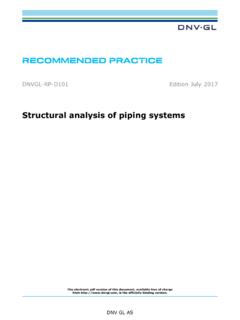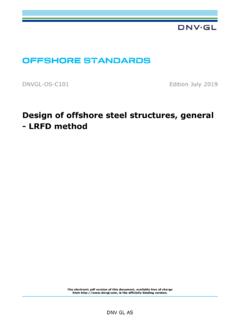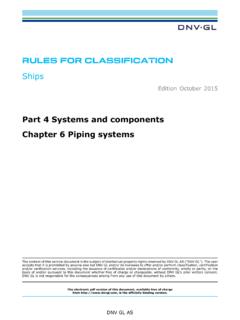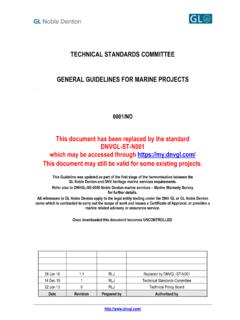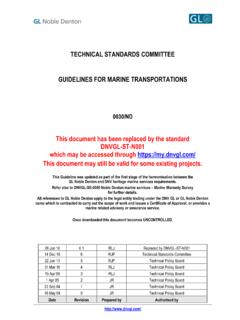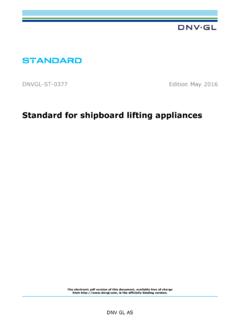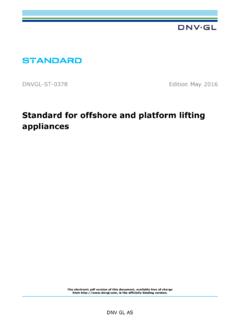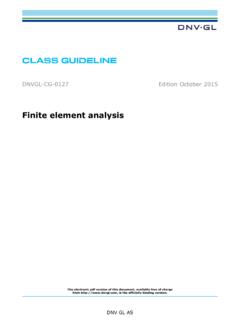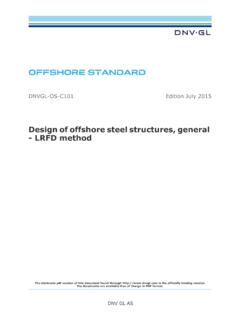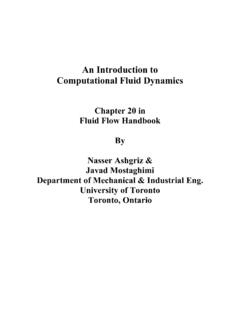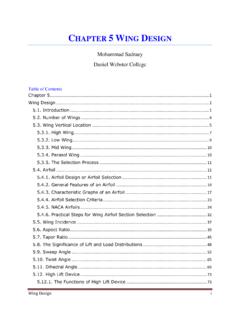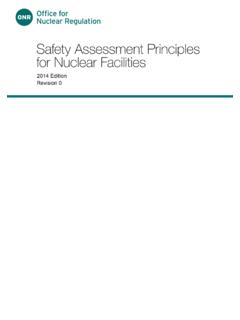Transcription of DNVGL-CG-0130 Wave loads
1 The content of this service document is the subject of intellectual property rights reserved by DNV GL AS ("DNV GL"). The useraccepts that it is prohibited by anyone else but DNV GL and/or its licensees to offer and/or perform classification, certificationand/or verification services, including the issuance of certificates and/or declarations of conformity, wholly or partly, on thebasis of and/or pursuant to this document whether free of charge or chargeable, without DNV GL's prior written GL is not responsible for the consequences arising from any use of this document by electronic pdf version of this document, available free of chargefrom , is the officially binding GL ASCLASS GUIDELINEDNVGL-CG-0130 Edition January 2018 Wave loadsFOREWORDDNV GL class guidelines contain methods, technical requirements, principles and acceptancecriteria related to classed objects as referred to from the rules.
2 DNV GL AS January 2018 Any comments may be sent by e-mail to any person suffers loss or damage which is proved to have been caused by any negligent act or omission of DNV GL, then DNV GL shallpay compensation to such person for his proved direct loss or damage. However, the compensation shall not exceed an amount equal to tentimes the fee charged for the service in question, provided that the maximum compensation shall never exceed USD 2 this provision "DNV GL" shall mean DNV GL AS, its direct and indirect owners as well as all its affiliates, subsidiaries, directors, officers,employees, agents and any other acting on behalf of DNV GL. Changes - currentClass guideline DNVGL-CG-0130 . Edition January 2018 Page 3 Wave loadsDNV GL ASCHANGES - CURRENTThis is a new document. ContentsClass guideline DNVGL-CG-0130 . Edition January 2018 Page 4 Wave loadsDNV GL ASCONTENTSC hanges - 1 Symbols and Rule Methods for hydrodynamic Load 178 Additional class 2 Wave Regular 213 Wave Wave energy Zero up-crossing period, Tz and peak period Scatter Adjustment for routing and 28 Section 3 Equation of Irregular Wave induced Linear 4 Short term Long term Probability of Return period and up-crossing Coefficient of 5 Linear ContentsClass guideline DNVGL-CG-0130 .
3 Edition January 2018 Page 5 Wave loadsDNV GL AS2 Frequency 404 Time 41 Section 6 Non Linear Non-linear Frequency 444 Time 446 46 Section 7 Procedure for directly calculated rule 491 Scatter 493 Wave Wave energy Heading 496 Weather 498 Return Non-linear 5010 Loading 5211 Combination of 8 Equivalent design Basic 533 EDWs used in the 544 Establishing EDWs from first Establishing corrected rule Load application for different ship 56 Section 9 Procedure for CSA - component stochastic 571 Basic 583 Structural Load Stress factors per unit ContentsClass guideline DNVGL-CG-0130 . Edition January 2018 Page 6 Wave loadsDNV GL AS6 From load to stress transfer Splash zone 618 Fatigue damage Extreme 10 Procedure for CSA - full stochastic 631 Basic 643 Global FE Local FE loads and load 647 FLS and 65 Section 11 Procedure for equivalent design wave approach (RSD).
4 661 12 671 Mass Panel Volume Quality 72 Section 13 A Transfer of loads to structural 762 Transfer of external 773 Applying internal Idealisation of internal 1 Class guideline DNVGL-CG-0130 . Edition January 2018 Page 7 Wave loadsDNV GL ASSECTION 1 GENERAL1 ObjectiveThis class guideline gives a transparent and detailed description of the hydrodynamic analysis methods andprocedures to support and satisfy requirements given in DNVGL-RU-SHIP , DNVGL-RU-SHIP andDNVGL-RU-SHIP ScopeThis class guidelines covers the procedures for calculation of wave induced loads , ship motions andaccelerations of monohull displacement ships. to describe the approaches to calculate loadsaccording to the rules for classification. to contain more detailed descriptions of wave conditions,statistics, concepts and approaches, which may be referred to in to Sec.
5 12 covers aspectsrelated to modelling and quality assurance. Hydroelastic responses like whipping and springing are coveredby Symbols and SymbolsThe symbols in Table 1 are used in this class guideline. For symbols not defined in this class guideline,reference is made to DNVGL-RU-SHIP 1 Symbol listSymbolMeaningUnit heading angledeg pprincipal heading angledeg roll angledeg iphase anglerad pitch angledeg wave lengthm density; salt water = ; fresh water = up-crossing frequency1/s surface elevationm wave frequencyrad/s ppeak wave frequencyrad/s eencounter frequencyrad/s nnatural frequencyrad/sSection 1 Class guideline DNVGL-CG-0130 . Edition January 2018 Page 8 Wave loadsDNV GL ASSymbolMeaningUnit moulded displacement at draught TSCt gamma function-aaccelerationm/s2anodal acceleration vector (FE model)m/s2 Awave amplitudemACcrest heightmATtrough heightmAadded mass matrixtBmoulded breadth of shipmBdamping matrixNs/mCBblock coefficient at draught TSC-cggroup velocitym/scphase velocitym/sCstiffness matrixN/mDmoulded depth of shipmD( )wave energy spreading-dwater depthmfwave frequencyHz = 1/sfnodal force vector (FE model)kNfeenvironmental factor-fpdown scaling factor-fRoperational factor-f'force vector (hydrodynamic model) at panel centreskNFgeneralised force for modal DOF (FE model) based on nodal forceskNF'generalised force for modal DOF (hydrodynamic model) based on forces at panelcentreskNFforcekNFrfroude number; ratio of gravity and inertia loads Fr = U/(g L)1/2-gacceleration of gravity =.
6 Distance from fluid surface to load pointmHwave heightmHbmaximum wave heightmHssignificant wave heightmSection 1 Class guideline DNVGL-CG-0130 . Edition January 2018 Page 9 Wave loadsDNV GL ASSymbolMeaningUnitI44mass moment of inertia in rollt m2I55mass moment of inertia in pitcht m2I66mass moment of inertia in yawt m2kwave number1/mkrradius of gyration in rollmLrule lengthmLPPlength between perpendicularsmLCGlongitudinal centre of gravity from aft perpendicularmmpoint masstm mass per meter along the hullt/mmTtotal mass of shiptMmomentkNmMmass matrix (FE model)tM'modal mass matrix (hydrodynamic model)tMwhhorizontal wave bending momentkNmMwttorsional wave momentkNmMwv-jvertical wave bending moment, j=h, s (hog, sag)kNmMsw-jvertical still water bending moment, j=h, s (hog, sag)kNmnnumber of cycles over a treshold-n0number of total cycles during the life time-qmodal displacements (hydrodynamic model)
7 MQprobability of exceedance-Qswvertical still water shear forcekNQwvvertical wave shear forcekNPWhydrodynamic pressurekN/m2 PWL-ihydrodynamic pressure at water line at probability level 10-i where i is 2 or 8kN/m2rnodal displacement vector (FE model)mr'displacement vector (hydrodynamic model) for panel centresmr55radius of gyration in pitchmr66radius of gyration in yawmSwave steepness of wave event-Smaxmaximum wave steepness of wave event-Section 1 Class guideline DNVGL-CG-0130 . Edition January 2018 Page 10 Wave loadsDNV GL ASSymbolMeaningUnitSSwave steep of sea state based on Tz-SPwave steepness of sea state based on Tp-Si( )wave spectrum, i = PM for Pierson-Moskowitz and i = J for Jonswapm2/sTconversion matrix from modal displacements in hydrodynamic model to nodaldisplacements in FE model-T'conversion matrix from modal displacements in hydrodynamic model todisplacements for hydrodynamic panel centres-Tmoulded draughtmTwave periodsTnnatural periodsT1expected (mean) wave periodsTactactual draught at position consideredmTfullfull load design draughtmTBAL ballast draught (minimum midship)
8 MTSCscantling draughtmTDesigndesign draughtmTdtime duration of a sea statesTDFdesign lifeyearsTppeak periodsTzzero up-crossing periodsTCGtransverse centre of gravity from centre linemUship forward speedm/sVmaximum service speedknotVCGvertical centre of gravity above base linemxhorizontal distance from origin of the coordinate systemmyhorizontal distance from origin of the coordinate systemmzvertical distance from origin of the coordinate systemmzsvertical distance from water line to water surfacemzWL-isplash zone extent at probability level 10-i, where i is 2 or AbbreviationsThe abbreviations in Table 2 is used in this class 1 Class guideline DNVGL-CG-0130 . Edition January 2018 Page 11 Wave loadsDNV GL ASTable 2 Abbreviation listAbbreviationMeaningAFaxial forceBEMboundary element methodCFDcomputational fluid dynamicsCLcentre lineCOGcentre of gravityCSRcommon structural rulesDOFdegree of freedomEDWequivalent design waveFEfinite elementFEAfinite element analysisFEMfinite element methodHBMhorizontal bending momentHFhigh frequency (vibration response)HSFhorizontal shear forceLCFload combination factorLFlow frequency (slow drift motion)LTRlong term responseNAnorth atlanticpdfprobability density functionRAOresponse amplitude operatorREC.
9 Recommendations numberRPrecommended practiceSTFshort term responseTRFtransfer functionTMtorsional momentUR S11 IACS unified requirement - longitudinal strength standardVBMvertical bending momentVSFvertical shear forceWFwave frequency (wave response)WWworld wideSection 1 Class guideline DNVGL-CG-0130 . Edition January 2018 Page 12 Wave loadsDNV GL Coordinate system and sign conventionsThe origin of the right hand Cartesian coordinate system has co-ordinates at LCG, COG and CL, see Figure1. x, y and z are longitudinal, transverse and vertical distance from the origin to the motion point corresponds to the coordinate system given in DNVGL-RU-SHIP to define positive motions,relevant to define inertia loads or internal pressure loads . Positive hull girder loads are also defined inDNVGL-RU-SHIP and refer to the origin located at the neutral axes. Positive hull girder loads areillustrated in Figure 2.
10 Figure 1 Coordinate system for positive motionsSection 1 Class guideline DNVGL-CG-0130 . Edition January 2018 Page 13 Wave loadsDNV GL AS Figure 2 Sign conventions for shear forces QSW, QWV and bending moments MSW, MWV, MWH, MSTand MWT3 DefinitionsA list of definitions is given in Table 3 DefinitionsTermExplanationDispersion relationThe relationship between the wave period T, in s, and the wave length , in relation depends on the water depth d, in periodThe wave or response period, T1, in s, in a short term sea state associated with50% of being exceeded in the probability density velocitycg is the speed of wave energy transfer, the speed of the wave front in awave train, in m/s, the speed of the moving wave train, being less than thespeed of the phase regular wavesAsymmetric waves, AC > AT, where the phase velocity depends on wave height, the dispersion relation is a functional relationship between T.
